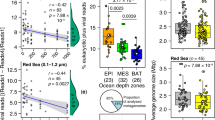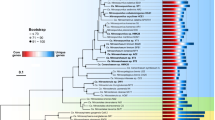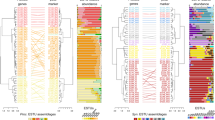Abstract
Surface ocean waters are dominated by planktonic bacterial lineages with highly reduced genomes. The best examples are the cyanobacterial genus Prochlorococcus, the alphaproteobacterial clade SAR11 and the gammaproteobacterial clade SAR86, which together represent over 50% of the cells in surface oceans. Several studies have identified signatures of selection on these lineages in today's ocean and have postulated selection as the primary force throughout their evolutionary history. However, massive loss of genomic DNA in these lineages often occurred in the distant past, and the selective pressures underlying these ancient events have not been assessed. Here, we probe ancient selective pressures by computing %GC-corrected rates of conservative and radical nonsynonymous nucleotide substitutions. Surprisingly, we found an excess of radical changes in several of these lineages in comparison to their relatives with larger genomes. Furthermore, analyses of allelic genome sequences of several populations within these lineages consistently supported that radical replacements are more likely to be deleterious than conservative changes. Our results suggest coincidence of massive genomic DNA losses and increased power of genetic drift, but we also suggest that additional evidence independent of the nucleotide substitution analyses is needed to support a primary role of genetic drift driving ancient genome reduction of marine bacterioplankton lineages.
This is a preview of subscription content, access via your institution
Access options
Access Nature and 54 other Nature Portfolio journals
Get Nature+, our best-value online-access subscription
$29.99 / 30 days
cancel any time
Subscribe to this journal
Receive 12 digital issues and online access to articles
$119.00 per year
only $9.92 per issue
Buy this article
- Purchase on Springer Link
- Instant access to full article PDF
Prices may be subject to local taxes which are calculated during checkout




Similar content being viewed by others
References
Giovannoni, S. J., Thrash, J. C. & Temperton, B. Implications of streamlining theory for microbial ecology. ISME J. 8, 1553–1565 (2014).
Swan, B. K. et al. Prevalent genome streamlining and latitudinal divergence of planktonic bacteria in the surface ocean. Proc. Natl Acad. Sci. USA 110, 11463–11468 (2013).
Dufresne, A., Garczarek, L. & Partensky, F. Accelerated evolution associated with genome reduction in a free-living prokaryote. Genome Biol. 6, R14 (2005).
Viklund, J., Ettema, T. J. G. & Andersson, S. G. E. Independent genome reduction and phylogenetic reclassification of the oceanic SAR11 clade. Mol. Biol. Evol. 29, 599–615 (2012).
Batut, B., Knibbe, C., Marais, G. & Daubin, V. Reductive genome evolution at both ends of the bacterial population size spectrum. Nat. Rev. Microbiol. 12, 841–850 (2014).
Morris, J. J., Lenski, R. E. & Zinser, E. R. The black queen hypothesis: evolution of dependencies through adaptive gene loss. mBio 3, e00036–12 (2012).
Giovannoni, S. J. et al. Genome streamlining in a cosmopolitan oceanic bacterium. Science 309, 1242–1245 (2005).
O'Malley, M. A., Wideman, J. G. & Ruiz-Trillo, I. Losing complexity: the role of simplification in macroevolution. Trends Ecol. Evol. 31, 608–621 (2016).
Wernegreen, J. J. Endosymbiont evolution: predictions from theory and surprises from genomes. Ann. NY Acad. Sci. 1360, 16–35 (2015).
Button, D. K. Biochemical basis for whole-cell uptake kinetics: specific affinity, oligotrophic capacity, and the meaning of the Michaelis constant. Appl. Environ. Microbiol. 57, 2033–2038 (1991).
Biller, S. J., Berube, P. M., Lindell, D. & Chisholm, S. W. Prochlorococcus: the structure and function of collective diversity. Nat. Rev. Microbiol. 13, 13–27 (2015).
Karcagi, I. et al. Indispensability of horizontally transferred genes and its impact on bacterial genome streamlining. Mol. Biol. Evol. 33, 1257–1269 (2016).
Kurokawa, M., Seno, S., Matsuda, H. & Ying, B.-W. Correlation between genome reduction and bacterial growth. DNA Res. 23, 517–525 (2016).
Kashtan, N. et al. Single-cell genomics reveals hundreds of coexisting subpopulations in wild Prochlorococcus. Science 344, 416–420 (2014).
Luo, H., Swan, B. K., Stepanauskas, R., Hughes, A. L. & Moran, M. A. Comparing effective population sizes of dominant marine Alphaproteobacteria lineages. Environ. Microbiol. Rep. 6, 167–172 (2014).
Charlesworth, B. Effective population size and patterns of molecular evolution and variation. Nat. Rev. Genet. 10, 195–205 (2009).
Osburne, M. S., Holmbeck, B. M., Coe, A. & Chisholm, S. W. The spontaneous mutation frequencies of Prochlorococcus strains are commensurate with those of other bacteria. Environ. Microbiol. Rep. 3, 744–749 (2011).
Sánchez-Baracaldo, P., Ridgwell, A. & Raven John, A. A neoproterozoic transition in the marine nitrogen cycle. Curr. Biol. 24, 652–657 (2014).
Rocap, G. et al. Genome divergence in two Prochlorococcus ecotypes reflects oceanic niche differentiation. Nature 424, 1042–1047 (2003).
Partensky, F. & Garczarek, L. Prochlorococcus: advantages and limits of minimalism. Ann. Rev. Mar. Sci. 2, 305–331 (2010).
Luo, H., Friedman, R., Tang, J. & Hughes, A. L. Genome reduction by deletion of paralogs in the marine cyanobacterium Prochlorococcus. Mol. Biol. Evol. 28, 2751–2760 (2011).
Sunagawa, S. et al. Structure and function of the global ocean microbiome. Science 348, 1261359 (2015).
Luo, H. Evolutionary origin of a streamlined marine bacterioplankton lineage. ISME J. 9, 1423–1433 (2015).
Dayhoff, M., Eck, R. & Park, C. in Atlas of Protein Sequence and Structure (ed. Dayhoff, M. O. ) 89–100 (National Biomedical Research Foundation, 1972).
Zuckerkandl, E. & Pauling, L. in Evolving Genes and Proteins (eds Bryson, V. & Vogel, H. J. ) 97–116 (Academic, 1965).
Wernegreen, J. J. Reduced selective constraint in endosymbionts: elevation in radical amino acid replacements occurs genome-wide. PLoS ONE 6, e28905 (2011).
Hughes, A. L. & Friedman, R. More radical amino acid replacements in primates than in rodents: support for the evolutionary role of effective population size. Gene 440, 50–56 (2009).
Eyre-Walker, A., Keightley, P. D., Smith, N. G. C. & Gaffney, D. Quantifying the slightly deleterious mutation model of molecular evolution. Mol. Biol. Evol. 19, 2142–2149 (2002).
Zhang, J. Rates of conservative and radical nonsynonymous nucleotide substitutions in mammalian nuclear genes. J. Mol. Evol. 50, 56–68 (2000).
Hughes, A. L., Ota, T. & Nei, M. Positive Darwinian selection promotes charge profile diversity in the antigen-binding cleft of class I major-histocompatibility-complex molecules. Mol. Biol. Evol. 7, 515–524 (1990).
Luo, H., Swan, B. K., Stepanauskas, R., Hughes, A. L. & Moran, M. A. Evolutionary analysis of a streamlined lineage of surface ocean roseobacters. ISME J. 8, 1428–1439 (2014).
Moore, C. M. et al. Processes and patterns of oceanic nutrient limitation. Nat. Geosci. 6, 701–710 (2013).
Grzymski, J. J. & Dussaq, A. M. The significance of nitrogen cost minimization in proteomes of marine microorganisms. ISME J. 6, 71–80 (2012).
Biller, S. J. et al. Genomes of diverse isolates of the marine cyanobacterium Prochlorococcus. Sci. Data 1, 140034 (2014).
Nei, M. Molecular Evolutionary Genetics (Columbia Univ. Press, 1987).
Hughes, A. L. et al. Widespread purifying selection at polymorphic sites in human protein-coding loci. Proc. Natl Acad. Sci. USA 100, 15754–15757 (2003).
Marais, G., Calteau, A. & Tenaillon, O. Mutation rate and genome reduction in endosymbiotic and free-living bacteria. Genetica 134, 205–210 (2008).
Taddei, F. et al. Role of mutator alleles in adaptive evolution. Nature 387, 700–702 (1997).
Sniegowski, P. D., Gerrish, P. J. & Lenski, R. E. Evolution of high mutation rates in experimental populations of E. coli. Nature 387, 703–705 (1997).
Tenaillon, O., Toupance, B., Le Nagard, H., Taddei, F. & Godelle, B. Mutators, population size, adaptive landscape and the adaptation of asexual populations of bacteria. Genetics 152, 485–493 (1999).
Paul, S., Dutta, A., Bag, S., Das, S. & Dutta, C. Distinct, ecotype-specific genome and proteome signatures in the marine cyanobacteria Prochlorococcus. BMC Genomics 11, 103 (2010).
Viklund, J., Martijn, J., Ettema, T. J. G. & Andersson, S. G. E. Comparative and phylogenomic evidence that the Alphaproteobacterium HIMB59 is not a member of the oceanic SAR11 clade. PLoS ONE 8, e78858 (2013).
Amrine, K. C. H., Swingley, W. D. & Ardell, D. H. tRNA signatures reveal a polyphyletic origin of SAR11 strains among Alphaproteobacteria. PLoS Comput. Biol. 10, e1003454 (2014).
Rodríguez-Ezpeleta, N. & Embley, T. M. The SAR11 group of Alpha-Proteobacteria is not related to the origin of mitochondria. PLoS ONE 7, e30520 (2012).
Zaremba-Niedzwiedzka, K. et al. Single-cell genomics reveal low recombination frequencies in freshwater bacteria of the SAR11 clade. Genome Biol. 14, R130 (2013).
Thrash, J. C. et al. Single-cell enabled comparative genomics of a deep ocean SAR11 bathytype. ISME J. 8, 1440–1451 (2014).
Lee, H., Popodi, E., Tang, H. & Foster, P. L. Rate and molecular spectrum of spontaneous mutations in the bacterium Escherichia coli as determined by whole-genome sequencing. Proc. Natl Acad. Sci. USA 109, E2774–E2783 (2012).
Long, H. et al. Background mutational features of the radiation-resistant bacterium Deinococcus radiodurans. Mol. Biol. Evol. 32, 2383–2392 (2015).
Sung, W. et al. Asymmetric context-dependent mutation patterns revealed through mutation-accumulation experiments. Mol. Biol. Evol. 32, 1672–1683 (2015).
Johnson, Z. I. et al. Niche partitioning among Prochlorococcus ecotypes along ocean-scale environmental gradients. Science 311, 1737–1740 (2006).
Yang, Z. PAML: a program package for phylogenetic analysis by maximum likelihood. Bioinformatics 13, 555–556 (1997).
Smith, N. C. Are radical and conservative substitution rates useful statistics in molecular evolution? J. Mol. Evol. 57, 467–478 (2003).
Stamatakis, A. RAxML version 8: a tool for phylogenetic analysis and post-analysis of large phylogenies. Bioinformatics 30, 1312–1313 (2014).
Acknowledgements
This research was funded by the National Natural Science Foundation of China (41576141), the Hong Kong RGC Early Career Scheme (24101015), the Hong Kong Environment and Conservation Fund (15/2016), the Chinese University of Hong Kong (Direct Grants 4930062 and 4053105) and the US National Science Foundation (IIS 1161586 to J.T. and OCE-1232982 and DEB-1441717 to R.S.).
Author information
Authors and Affiliations
Contributions
H.L. conceived and designed the study. Y.H. performed the research. R.S. and J.T. contributed reagent and analytic tools. H.L., Y.H., R.S. and J.T. analysed the data. H.L. wrote the paper.
Corresponding author
Ethics declarations
Competing interests
The authors declare no competing financial interests.
Supplementary information
Supplementary Information
Supplementary Methods, Supplementary Figures, Supplementary Table and Supplementary References. (PDF 8419 kb)
Supplementary Data
(1) Summary of simulation parameters used to estimate the dR/dC ratio based on charge classification of the 20 amino acids. (2) Summary of simulation parameters used to estimate the dR/dC ratio based on volume and polarity classification of the 20 amino acids. (XLSX 290 kb)
Rights and permissions
About this article
Cite this article
Luo, H., Huang, Y., Stepanauskas, R. et al. Excess of non-conservative amino acid changes in marine bacterioplankton lineages with reduced genomes. Nat Microbiol 2, 17091 (2017). https://doi.org/10.1038/nmicrobiol.2017.91
Received:
Accepted:
Published:
DOI: https://doi.org/10.1038/nmicrobiol.2017.91
This article is cited by
-
A social niche breadth score reveals niche range strategies of generalists and specialists
Nature Ecology & Evolution (2023)
-
Abiotic selection of microbial genome size in the global ocean
Nature Communications (2023)
-
Mechanisms driving genome reduction of a novel Roseobacter lineage
The ISME Journal (2021)
-
Prochlorococcus have low global mutation rate and small effective population size
Nature Ecology & Evolution (2021)
-
Unexpectedly high mutation rate of a deep-sea hyperthermophilic anaerobic archaeon
The ISME Journal (2021)



